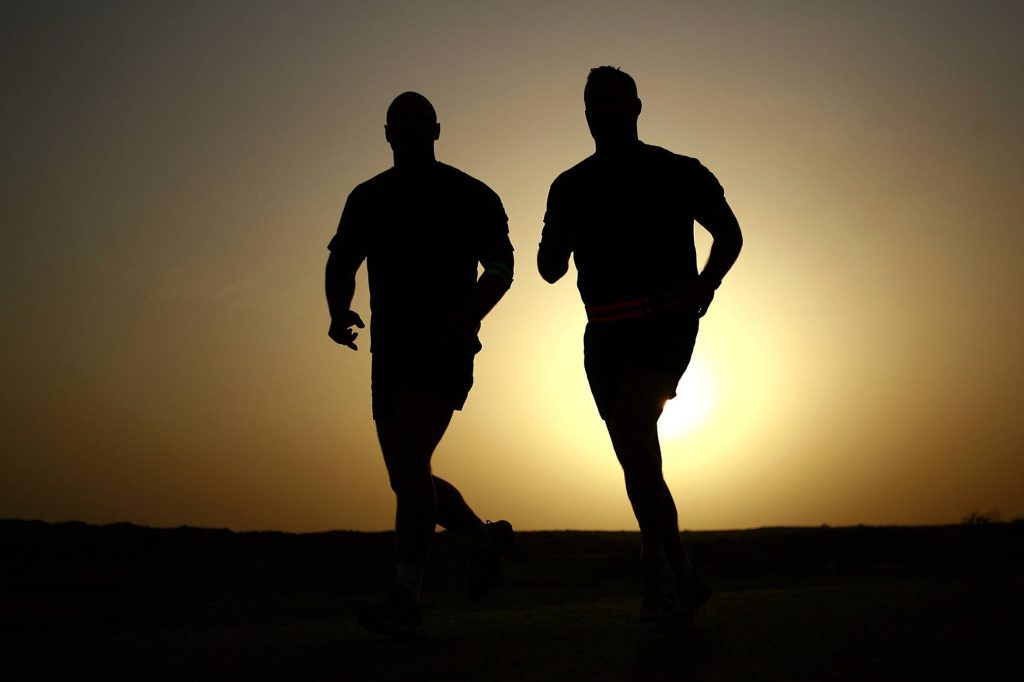Tired of not being able to do the physical stuff you used to be able to do? Wanting to ditch the muffin top? Tired of being tired?
It’s time to step up the fitness game. And the good news is that you can start doing that no matter what age you are. It’s never too late (or too early). It might feel a bit tough to get the big old rusty engine of the fitness train in motion. But I think I’ve found the key to putting that behemoth in motion and getting into a regular exercise routine… and it’s kind of anti-shocking.
The key is fun.
On the Bad-Ass Dad Podcast, I’ve talked with several mature athletes who have upped their game while in middle age–including Over the Hill Dunker Andy Nicholson and “Grampa” American Ninja Warrior Jon Stewart–and they’ve made it clear they continue to pursue their physical training passionately because they’re having fun.
The key to motivation on your physical quest is having fun.
Conversations I’ve had with other “over-the-hill” athletes include:
- A talk about a legacy of fitness with trainer and podcaster Matt Pendola
- A conversation about getting things started with runner and LIFE coach Colin Thompson
How to make fitness fun
Motivation doesn’t have to be tricky. Most of us do not have a hard time getting motivated to play. So one way to motivate ourselves to get up and physically train is to turn training into a kind of game. And there are many ways to do this.
I’ve gamified training by assigning point values to different training activities and then reward myself when I surpass certain point totals (or levels).
https://open.spotify.com/embed-podcast/episode/4InZNs3w1VJ2Wy8Uo7R93U?si=U6beSIiATE2QVexTDvlUFg
But probably even more central to sustained training is making our fitness goals fun. Let’s face it, losing 30 pounds is not a fun goal… but dunking a basketball sounds exciting, doesn’t it?!
That’s where my fitness journey began. At the age of 43, I decided I wasn’t prepared to admit my best years were past. So I committed to do something I had never achieved when I was younger: I committed to dunk a basketball.
Getting stronger and losing weight are implicit in achieving that goal. BUT, they are not the fun motivating factors behind my training. I train because it’s really fun to try and dunk a basketball.
Are there similar goals you might find fun and motivating? Maybe running a half-marathon sounds fun. Maybe it’s hitting a 300-yard drive from the tee. Maybe it’s belting up in Jiu-Jitsu. There’s some fun idea inside of you that’s the key to unlocking a motivation for fitness.
How are you going to fit in your new goals? Jeff Sanders, host of the 5 AM Miracle, helps us get centered and motivated. You got this!
Can a middle-aged man dunk?
I’m not the first person to try dunking for the first time at this age. It can be done. And here’s how I’ve set about to achieve this goal:
What you need to know about getting lean:
It’s a lot of work to get 230 pounds up to a basketball rim. It’s a lot less work to get 195 pounds up there. Trying to get down to 195 pounds is where my fitness quest began.
And, guess what: getting from 230 to 210 was easy! I simply counted my calories, making sure I consumed fewer calories than I burned up. It was amazing to watch the weight melt away.
Then I hit 206 pounds… and I stayed there. And stayed there. And stayed there some more.
It was time to try something new. So I took a solid assessment of my diet–specifically what it was comprised of–in order to get over the 206-pound plateau. If I was going to get lean, I needed to eat lean in the form of eating enough protein to fuel my muscles and keeping my body out of starvation mode. Starvation mode is a metabolic state where our bodies conserve energy and hold on to fat.
My rule of thumb: eat a gram of protein per pound of body weight.
I’ve discovered another key to get lean: what you eat is more important than what you do. I can exercise like crazy (which I’ve done) and not lose an ounce of weight because I’m not paying attention to my nutrition. Nutrition is key to getting lean. Working out helps, but nutrition is what will make or break a fat loss regimen.
What you need to know about getting stronger:
Besides reducing the amount of mass I pushed towards the basketball rim, I also needed to increase my pushing force. I needed to get stronger–especially in my legs.
Squats are key to strengthening the muscles used in jumping towards a basketball goal. When COVID-19 struck our area and gyms closed, I pieced together this at-home lower-body workout to keep strengthening my legs (and the rest of me, too).
I learned that one of the keys to muscle growth when “lifting” with light weights (like these body-weight exercises) is time under tension. Here’s the deal: I don’t have equipment available to do a 300-pound squat. I actually don’t have the equipment available to do 80% of my maximum squat. I just have me and a kettle bell. But by making sure I’m spending 40-60 seconds doing a set at low weight, I’m working the muscle harder and causing it break down just a bit more.
And that leads to next key of getting stronger: take time to rest. Lifting weights does not actually make you strong. Resting after lifting weights does! Weightlifting breaks down a muscle. When we rest, the muscle grows back a little bit stronger–but the muscle needs time and nutrition (protein) to do so. So in your hurry to strengthen up those legs and go for the dunk, make sure you carve space for recovery. A good rule of thumb (at my age) is to rest a muscle group for two days after a workout.
More tips and workouts:
How to Breathe While Lifting Weights
The deadlift: it’s a most efficient exercise. It also makes me feel like passing out. What’s going on when I’m weightlifting?
What you need to know about getting faster:
Doing something like dunking a basketball requires considerable explosiveness.
I have never been referred to as “explosive.” Ever.
So how do I–a guy who lives by the mantra “slow and steady wins the race”–get my muscles trained for explosive movements? By doing the thing I am training to do. If I want to be explosive, I have to practice explosive movements.
If you want to jump high, you have to practice jumping high.
This means I spend a lot of time jumping at a basketball rim. It’s been fun to see my slow improvement in first touching the net, then the rim, then wrapping my hand on the rim.
Plyometrics provide a methodical to training for explosiveness. Plyometrics are simply jumping exercises. They give a method to jumping high. This video provides several examples:
It’s fun work…
It all sounds like a lot of work. Much of it is… but it’s fun work.
And here’s what it’s led to so far… my jump progression:
Ryan Dunn has a bunch of certificates on his desk. A few are awards for content production and marketing. Ryan still seeks to achieve. He would like to be a faster runner and higher jumper. He wants to read more books while somehow watching all the Cubs games possible. He would like to produce more written words–though not in this bio.


